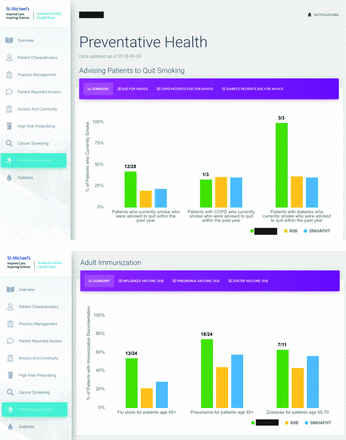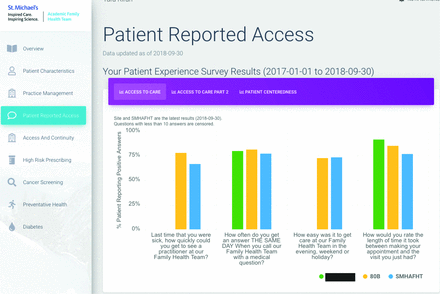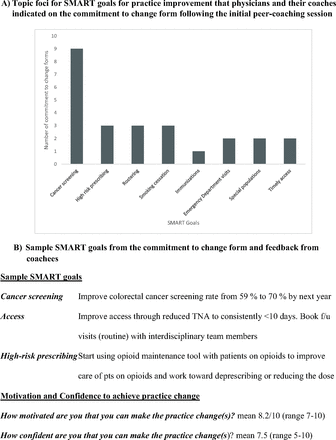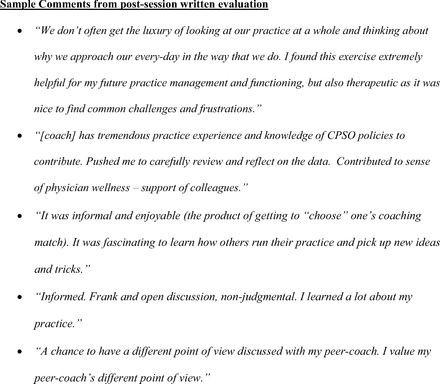Article Figures & Data
Figures
Tables
- Table 1.
Characteristics of Coachees Who Participated in Peer-Coaching Sessions Compared to All Staff Physicians in the Primary Organization (2019)
Coachees (n = 25) All Staff Physicians (n = 75) n % n % Gender Women 15 60 51 68 Men 10 40 24 32 Graduation year range 1977 to 2015 1977 to 2015 Graduation year 1977 to 2001 7 28 25 33 2002 to 2007 9 36 17 23 2008 to 2015 9 36 33 44 FTE range 0.3 to 1.0 0.2 to 1.0 FTE 0.2 to 0.5 12 48 27 36 >0.5 to 1 13 52 48 64 Abbreviation: FTE, Full-time equivalent.
- Table 2.
Results of the Self-Assessment Survey Completed by Coaches After Their Coaching Session to Assess Fidelity to the Planned R2C2-Informed Coaching Approach
Question n = 24 How long did the conversation last (approx.)? Mean (range) 37 minutes (20 to 60) Was a follow-up call scheduled? Yes N (%) 5 (21%) How much do you agree or disagree with each of the following statements. Strongly agree/agree N (%) The physician I coached thought the feedback was valuable. 22 (93%) The physician demonstrated understanding and cooperativeness. 24 (100%) The physician demonstrated self-reflection, self-awareness, and insight. 24 (100%) The physician was able to develop a change plan. 24 (100%) The physician demonstrates thecommitment to making thechange. 23 (96%) Did you apply part or the entire R2C2 model over the course of your conversation? Yes N (%) 18 (75%) Which of the following R2C2 stages did you use over the course of your conversation? N (%) of respondents Build rapport and relationship 20 (83%) Explore reactions to and perceptions of the data/report 22 (92%) Explore physician understanding of the content of the data/report 22 (92%) Coach for performance change 22 (92%) None 1 (4%) Which of the following R2C2 stages would you like to improve on for your next conversation? N (%) of respondents Build rapport and relationship 4 (17%) Explore reactions to and perceptions of the data/report 7 (29%) Explore physician understanding of the content of the data/report 10 (42%) Coach for performance change 20 (83%) None 2 (8%) Abbreviation: R2C2, Report, React, Recommend, and Commit.
- Table 3.
Quotations from Coaches and Coachees Who Participated in the Focus Group and Interviews, Organized by the Sargeant’s R2C2 Facilitated Feedback Framework
Building Relationships “He's senior but not too senior so he's sort of, he is a peer and we have a good relationship going in so he's collegial, he's friendly, he's open-minded, he's non-judgemental which actually means a lot to me… we all want to be doing really well and we don't want to be making mistakes so to share that you know there's potentially gaps you want to be with somebody who you trust.” (Coachee 2302) “I found universally the conversation actually got back to individual providers' balance and wellness too because it's easy to say to fix this you just need to work harder or add more clinics but inevitably these one-on-one conversations got to like the root of who the person is and what their practice style is and trying to balance like what the outcome would be in terms of improving these numbers versus continuing to support their happiness and fulfillment as a doctor.” (Coach R8) “the first person that I was coaching is someone… who personality-wise I don't necessarily align with all the time but, and so I was quite nervous going into it and did a lot of preparation looking at the data and just feeling, making sure I had some talking points and it was actually amazing. It went so well. This person was very open to exploring the data and learning and setting goals and I came away from it actually feeling a) very positive and b) also that I had a new appreciation for this person so that was really nice” (Coach R3) Exploring Reactions “I was overwhelmed by my practice and the data was just like another part of it that felt overwhelming and so their kind of validation of my perception of my patient population and then practical like problem-solving, yeah, it made me feel less overwhelmed.” (Coachee 2303) “you feel like you're able to share your potential practice vulnerabilities without feeling as though you're really a negative anomaly like you're like oh, we're, you know we have similar habits and so now maybe we can share ideas and not feel intimidated or as though there's dissimilarity between the providers.” (Coachee 2302) “one of the challenges of course with the data is you feel a little bit hopeless about it like there are all these problems and what am I going to do about solving them and Lord knows I'm trying but…” (Coachee 1813) Exploring Content “It seems like a good idea… to better understand the data because as I said I did find it a bit overwhelming…I guess I was looking for someone to help me interpret it and kind of advise.” (Coachee 1813) “it was great cause she let me kind of drive what my priorities were but I also was able to ask her like was there anything else you noticed in my data as well.” (Coachee 2012) “the first one I think was more about we set priorities based on sort of that person's kind of, their, what stuck out to them kind of thing and what was relevant to them. The second one…we worked together to actually see you know what stuck out for each of us. It just proceeded differently. I think that we ended up in the same place.” (Coach R5) Coaching for Performance Change “I just think like if you have an opportunity to look over data with someone else like why wouldn't you take it because I think that when you look at the data on your own like I think it's harder to pick out areas that you can work on and to kind of do this actively so I think having a peer-coach like forces you to look at it in more detail and then also to set some goals on what you want to try to improve.” (Coachee 2306) “it was kind of helpful that she wasn't in my clinic because there were things that she was doing in her clinic or even their clinic as a whole that we do have little variations in that help improve some of the quality measures so I felt like maybe I had more to learn from her in some sense than the people I work right next to who we kind of do the same thing all the time as each other.” (Coachee 2012) Limitations and Dissent “The care is being delivered. It's just not being documented in a way that it can be tracked and therefore you know the data tells a different picture.” (Coachee 2307) “It makes me feel inadequate as a clinician to be measured on things that are small snippets of care that don't reflect a larger picture” (Coachee 2307) “I just don't know, like other physicians are too busy and then anybody else I feel like you're stepping on toes if you ask them to do more work like basically to improve your data requires more work which is fine but that's, time is limited for all of us. Everybody feels a bit overstretched so I'm hesitant to ask anybody to do anything to help.” (Coachee 2302) “[T]he critical or negative things are the hardest things to kind of take; however, they're often the most [Pause] useful because they do call us to action. They're the things that people remember the most, I think are the critical or negative things.” (Coachee 1805) Abbreviation: R2C2, Report, React, Recommend, and Commit.












